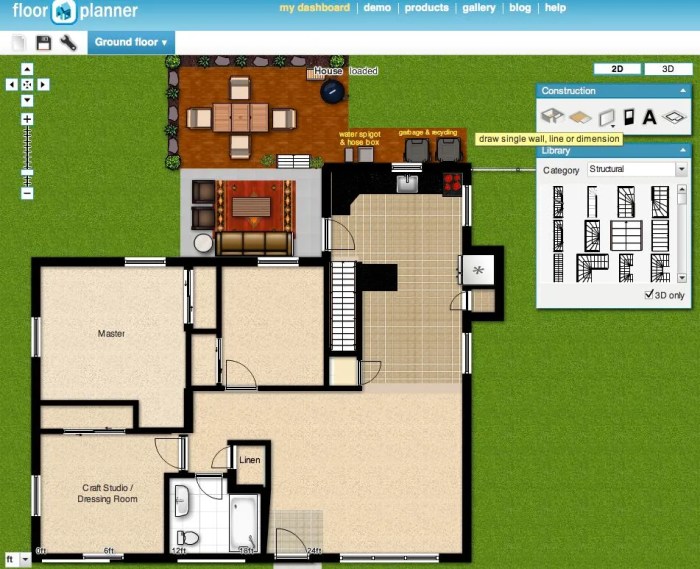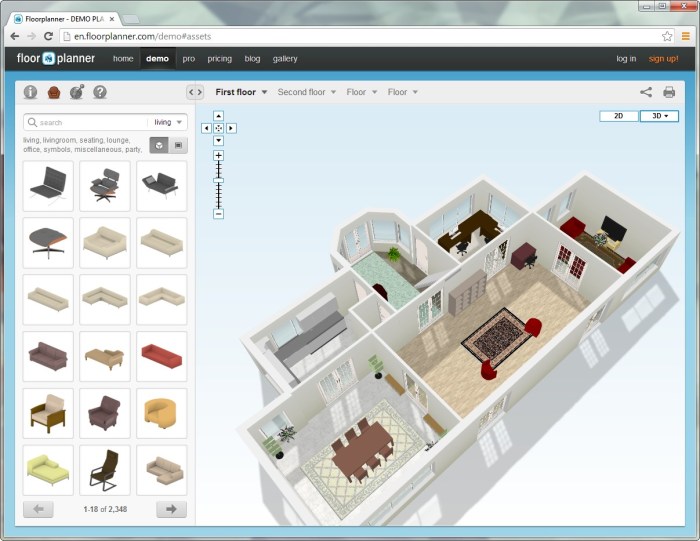Creating an Efficient Space: A Guide to Floor Planner
Embark on a journey into the world of floor planning, where creativity meets functionality to transform spaces into personalized havens. From designing the layout of a room to optimizing natural light, floor planners offer a versatile tool for crafting spaces that reflect individual style and needs.
Overview of Floor Planner

A floor planner is a digital tool used to create and design layouts for indoor spaces such as homes, offices, or retail stores. It allows users to visualize and plan the arrangement of furniture, fixtures, and other elements within a room or building.Using a floor planner is important for efficiently utilizing space and optimizing the functionality and aesthetics of a room.
It helps users experiment with different layouts, furniture placements, and design ideas without the need for physical rearrangement. This can save time, money, and effort in the actual implementation of the design.
Key Features of a Floor Planner Tool
- Customizable Room Dimensions: Users can input the exact dimensions of a room to accurately plan the layout.
- Furniture Library: Access to a library of furniture items to drag and drop into the floor plan for placement.
- 3D Visualization: Some floor planners offer 3D rendering to provide a realistic view of the designed space.
- Measurement Tools: Tools to measure distances, angles, and other dimensions within the floor plan.
- Collaboration: Ability to share and collaborate on floor plans with others, such as clients or colleagues.
Types of Floor Planners

When it comes to floor planners, there are two main types that are commonly used: 2D floor planners and 3D floor planners. Each type offers its own set of features and benefits depending on the user's needs and preferences.
2D Floor Planners vs. 3D Floor Planners
D floor planners are more basic and are typically used for simple floor plans and layouts. They provide a bird's eye view of the space, allowing users to create and customize floor plans with ease. On the other hand, 3D floor planners offer a more immersive experience by providing a three-dimensional view of the space.
This allows users to visualize the layout in a more realistic manner, including the ability to add furniture and decorations to see how they fit in the space.
Popular Floor Planner Software
- SketchUp: SketchUp is a popular software that offers both 2D and 3D floor planning capabilities. It is known for its user-friendly interface and extensive library of design elements.
- RoomSketcher: RoomSketcher is another widely-used floor planner that allows users to create detailed floor plans in both 2D and 3D. It offers features such as virtual staging and 3D walkthroughs.
- Sweet Home 3D: Sweet Home 3D is a free floor planner software that specializes in interior design. It allows users to create detailed floor plans and visualize their designs in 3D.
Benefits of Online vs. Offline Floor Planners
Online floor planners offer the advantage of accessibility from any device with an internet connection. Users can easily collaborate with others in real-time and save their designs in the cloud for easy access. Offline floor planners, on the other hand, provide the benefit of working without an internet connection, ensuring privacy and security of designs.
Users can also work offline without any interruption from connectivity issues.
Design Elements in Floor Planning
When it comes to floor planning, incorporating design elements is crucial to creating a functional and aesthetically pleasing space. By paying attention to furniture placement, color schemes, textures, natural light, and space utilization, you can transform a room into a well-designed area that meets your needs and preferences.
Incorporating Furniture Placement
- Consider the function of the room when placing furniture to ensure easy traffic flow and accessibility.
- Utilize furniture to define different areas within an open-concept space, creating a sense of organization and purpose.
- Experiment with different furniture arrangements to find the most visually appealing and practical layout.
Significance of Color Schemes and Textures
- Choose a color scheme that reflects your personal style and enhances the mood of the room.
- Use textures to add depth and visual interest to the space, creating a cozy and inviting atmosphere.
- Consider the impact of natural light on colors and textures, as they can change throughout the day.
Optimizing Natural Light and Space Utilization
- Maximize natural light by strategically placing windows and using light-colored finishes to reflect light.
- Consider the orientation of the room and how it affects natural light throughout the day.
- Utilize mirrors to bounce light around the room and create the illusion of more space.
Room-Specific Floor Planning
When it comes to room-specific floor planning, each area of the house requires careful consideration to ensure an efficient layout that meets the needs of the occupants. Let's delve into the key factors to keep in mind for kitchen, bedroom, and office spaces.
Kitchen Floor Planning
Designing a kitchen layout involves optimizing the space for cooking, storage, and functionality. Here are some considerations to keep in mind:
- Placement of appliances for a smooth workflow.
- Adequate counter space for meal preparation.
- Efficient storage solutions to keep the kitchen organized.
- Proper ventilation and lighting for a comfortable cooking environment.
Bedroom Layout
Creating a bedroom layout that promotes relaxation and restful sleep is essential. Key factors to consider include:
- Bed placement for optimal comfort and accessibility.
- Adequate storage for clothing and personal items.
- Lighting options for different activities, such as reading or relaxing.
- Decor elements that reflect the occupant's personal style and create a cozy atmosphere.
Efficient Office Space Design
Designing an office space that enhances productivity and creativity is crucial for remote work or a home office. Consider the following when planning an office layout:
- Ergonomic desk and chair setup for comfort during long work hours.
- Ample storage for files, supplies, and equipment to maintain an organized workspace.
- Proper lighting to reduce eye strain and boost focus.
- Zoning areas for different tasks, such as a work area, meeting space, and storage area.
Closing Summary
In conclusion, floor planning is not just about arranging furniture; it's about curating an environment that enhances daily living. By incorporating design elements and room-specific considerations, each space can be transformed into a harmonious blend of aesthetics and practicality. Dive into the realm of floor planning and unlock the potential to create spaces that inspire and uplift.
Detailed FAQs
How can I benefit from using a floor planner?
Using a floor planner helps visualize room layouts, experiment with design ideas, and optimize space functionality before making any physical changes.
What is the difference between 2D and 3D floor planners?
2D floor planners provide a top-down view, while 3D floor planners offer a more realistic perspective with depth and dimension.
Are there any free floor planner software options available?
Yes, some popular free floor planner software includes Floorplanner, Roomstyler, and Planner 5D.




